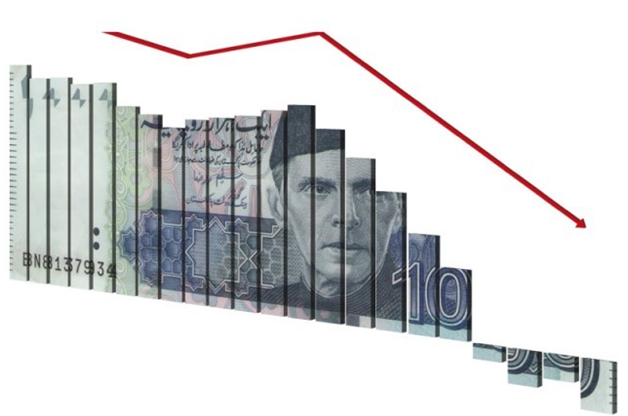The current government under the supervision of Prime Minister Shahbaz Sharif missed all important Economic indicators during the fiscal year 2022-23.
According to the Finance division, Federal Minister for Finance and Revenue Senator Mohammad Ishaq Dar will launch the Pakistan Economic Survey on Thursday June 08, 2023.
The Economic Survey will provide details about the major socio-economic developments, performance, and economic trends of various sectors of the economy including Agriculture, Manufacturing & Industry, Services, Energy, Information Technology & Telecom, Capital Markets, Health, Education, Transport and Communication etc.
Annual trends of major economic indicators regarding Inflation, Trade and Payments, Public Debt, Population, Employment, Climate Change, and Social Protections will also be described in detail in the economic survey.
Sources told Profit, that the country’s GDP stood at 0.3% in 2022-23 against the target of 5%. The government has set a 3.5% GDP target for next fiscal year 2023-24.
The growth in the agriculture sector declined to 1.5% against the target of 3.9% in 2022-23. The government has set a 3.5% agriculture target for next fiscal year 2023-24.
The growth in important crops remained negative 3.20% against the target of 3.5% in 2022-23. On the other hand, the livestock sector would remain at 3.8% in the current fiscal year.
The government has fixed a 3% growth target for important crops and a 3.6% growth target of Livestock for the next fiscal year 2023-24.
The growth in industry (manufacturing and Large Scale Manufacturing) remained negative as the government had set a 5.9% target of industry which was recorded at a negative 2.9%.
Major industries performed at -7.98% against the target of 7.4%; the target for electricity, gas, water supply was 3.5%, and they showed an efficiency of 6%.
The target for the construction sector was 4%, and it recorded a performance of -5.53%; the services sector’s target was 5.1%, while its performance remained 0.86%. The wholesale/retail sector target was 6.5%, while its performance remained at -4.46%.
The transport sector, an outlier, showed a growth performance of 4.73% against a target of 4.5%. The target for the real estate sector was set at 3.8%, while it recorded a performance of 3.72%. The performance of the public administration sector was recorded at -7.76% against a 4% target.
Sources said that the government has set a 3.4% target of industry, 4.3% Manufacturing and 3.2% Large Scale Manufacturing for next fiscal year 2023-24.
Meanwhile, the Services sector will also miss the target of 5.1% growth rate as it will remain at 0.9% in the current fiscal year, as per sources.
According to the document, the services sector target will be 3.6% for next fiscal year 2023-24.
Consumer Price Index- National was recorded 29.2% from July to May. This is an indicator for annual average inflation.
The CPI (urban) remained 26.8% which included Food 37.3%, non food 20.3%. Whereas CPI (Rural) remained 32.7% which included food 41%, and Non Food 25%. Inflation target for next year 2023-24 would be 21%.
The total investment in the current year will close near 13.6% against the target of 14.7%. On the other hand, National savings as well as Foreign Saving would be 12.5% and 1.1%, respectively.
Sources said that the government has set 13.4% National savings as well as 1.7% Foreign Saving targets for next fiscal year 2023-24.
As per the documents, the export target also could not be achieved during the current financial year.
Exports during July to April were recorded at $23.2 billion against the full year target of $32 billion. The export target of next year is likely to be set at $30 billion.
On the other hand, imports were recorded at $45.2 billion and the next year target of imports would be $58.7 billion.
Trade Balance would be $28.7 billion and the Current Account deficit projected is 6 billion next year which is 1.7 % of GDP.
According to details, the size of the country’s economy shrank to $341.50 billion. This financial year, the GDP saw a real decrease of $34 billion as compared to the last year.
In 2021-22, the size of the country’s economy was $375.4 billion. The per-capita income also decreased to $1,568 this fiscal year.
This figure saw a decrease by $198 as compared to the previous year. The per-capita income of Pakistan was $1,766 in the last financial year.
In rupees, the size of the country’s economy increased to Rs 84,760 billion mainly due to the free fall of rupee against the US dollar. As compared to the last fiscal year, the size of the economy saw an increase of Rs10,678 billion.
Similarly, in the local currency, the per-capita income saw an increase of Rs 75,418.
In the year 2022-23, the per capita income was recorded at Rs 388,755. In the previous year, the per-capita income was Rs313,337.
Sources said that the Economic Survey would also discuss Energy Conservation plan 2023.
According to details, Pakistan’s fuel import bill was $27 billion in 2021-22 which is unsustainable given foreign exchange constraints.
It warrants a concerted effort at the national level, for implementation of energy efficiency and conservation measures across the energy value chain.
National Energy Efficiency and Conservation Authority (NEECA) has formulated EE&C Policy 2023 approved by the Cabinet on 10th May 2023 which aims to achieve an energy saving equivalent to 9 million Tons of oil by 2030.




